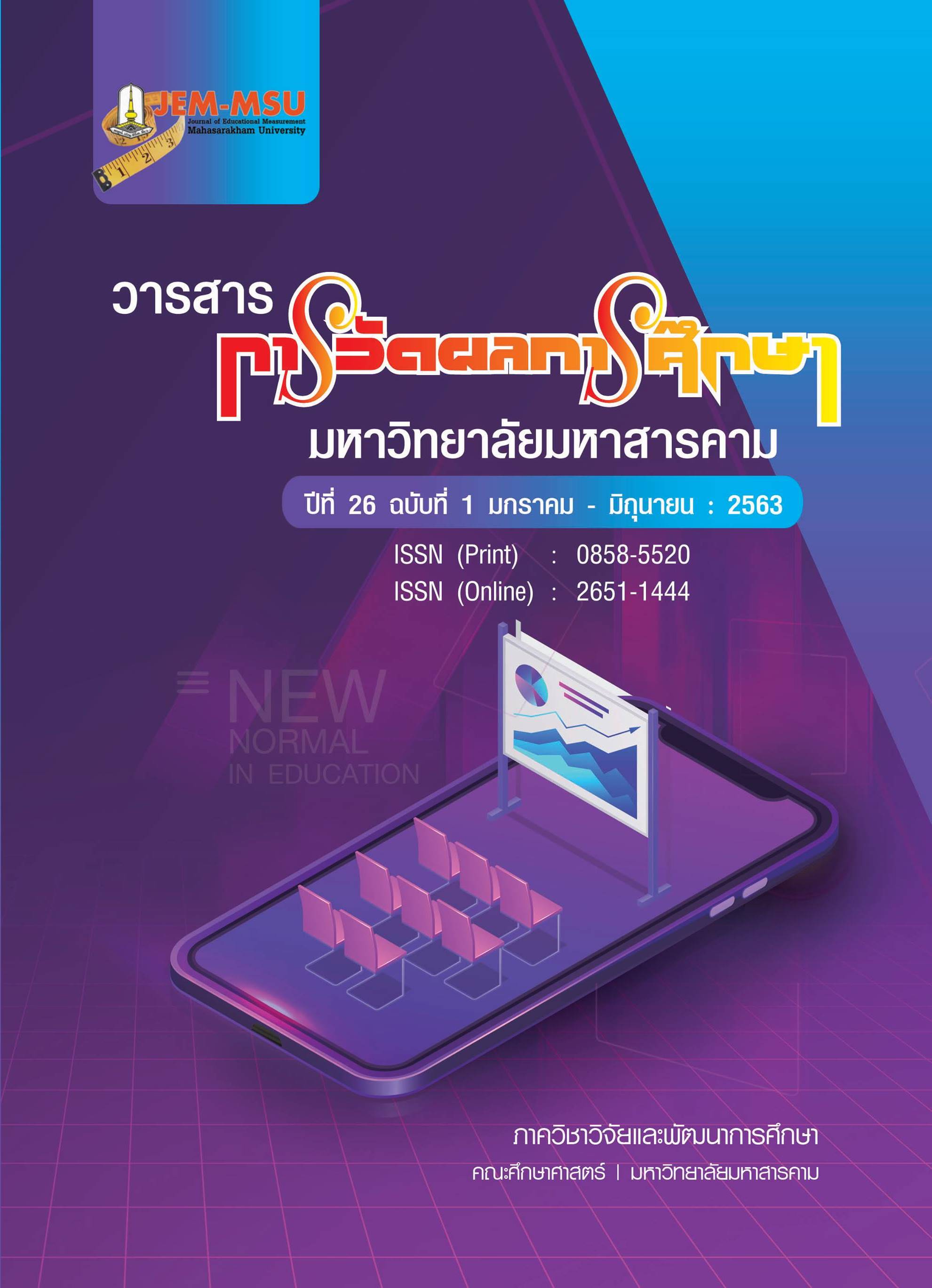Assessment Guidelines for Student’s Personalized Mathematical Proficiency Development
Main Article Content
Abstract
Assessing mathematical proficiency (MP) is considered an important factor in driving education forward, especially in mathematics education. An important challenge for teachers is how to assess students’ thinking and learning, especially assessing MP that does not only focus on the correct answer but also on the mathematical procedures as well, which is difficult in practice. Therefore, if mathematics teachers have assessment guidelines for personalized mathematical proficiency of a student, it will be greatly beneficial for learners to determine their learning path by themselves and for teachers to improve teaching procedures to suit the learners. The main objective of this article is to suggest new assessment guidelines for student’s personalized mathematical proficiency development as an alternative for mathematical classes. It will be presented in 4 steps according to the Constructing Modelling Approach (Wilson, 2005): (1) developing the MP construct map, (2) developing the tasks design according to the construct map, (3) providing the outcome space, and (4) analysing the measurement and interpretation models. Moreover, this article presents guidelines on providing important feedbacks for teachers and students which are: (1) feed up, (2) feedback, and (3) feed forward, for use in mathematical classes that are easy to apply and interpret learners in a more meaningful manner.
Article Details
The content and information contained in the published article in the Journal of Educational Measurement Mahasarakham University represent the opinions and responsibilities of the authors directly. The editorial board of the journal is not necessarily in agreement with or responsible for any of the content.
The articles, data, content, images, etc. that have been published in the Journal of Educational Measurement Mahasarakham University are copyrighted by the journal. If any individual or organization wishes to reproduce or perform any actions involving the entirety or any part of the content, they must obtain written permission from the Journal of Educational Measurement Mahasarakham University.
References
พัชรี จันทร์เพ็ง. (2561). การประยุกต์ทฤษฎีการตอบสนองข้อสอบแบบพหุมิติเพื่อการวิจัย. ขอนแก่น: โรงพิมพ์มหาวิทยาลัยขอนแก่น.
สถาบันส่งเสริมการสอนวิทยาศาสตร์และเทคโนโลยี (สสวท.), กระทรวงศึกษาธิการ. (2560). คู่มือการใช้ หลักสูตรกลุ่มสาระการเรียนรู้คณิตศาสตร์ (ฉบับปรับปรุง พ.ศ. 2560) ตามหลักสูตรแกนกลางการศึกษาขั้นพื้นฐาน พุทธศักราช 2551 ระดับประถมศึกษามัธยมศึกษาตอนต้น และมัธยมศึกษาตอนปลาย. [ออนไลน์]. ได้จาก http://www.ipst.ac.th [สืบค้นเมื่อ 7 ตุลาคม 2562].
สถาบันส่งเสริมการสอนวิทยาศาสตร์และเทคโนโลยี (สสวท.), กระทรวงศึกษาธิการ และ องค์การเพื่อความร่วมมือทางเศรษฐกิจและการพัฒนา (OECD). (2562). ผลการประเมิน PISA 2018 : บทสรุปสำหรับผู้บริหาร. [ออนไลน์]. ได้จาก https://pisathailand.ipst.ac.th/pisa2018-summary-result [สืบค้นเมื่อ 13 ธันวาคม 2562].
สำนักงานคณะกรรมการการศึกษาขั้นพื้นฐาน (สพฐ.), กระทรวงศึกษาธิการ. (2560). มาตรฐานการเรียนรู้และตัวชี้วัด กลุ่มสาระการเรียนรู้คณิตศาสตร์ วิทยาศาสตร์และสาระภูมิศาสตร์ ในกลุ่มสาระการเรียนรู้สังคมศึกษา ศาสนา และวัฒนธรรม (ฉบับปรับปรุง พ.ศ. 2560) ตามหลักสูตรแกนกลางการศึกษาขั้นพื้นฐาน พุทธศักราช 2551. กรุงเทพมหานคร: โรงพิมพ์ชุมนุมสหกรณ์การเกษตรแห่งประเทศไทย จำกัด.
สำรวน ชินจันทึก และคณะ. (2561). การประเมินความสามารถในการแก้ปัญหาทางคณิตศาสตร์เรื่อง เศษส่วนของนักเรียน 385 ระดับชั้นมัธยมศึกษาปีที่ 1 โรงเรียนสาธิตมหาวิทยาลัยขอนแก่น ฝ่ายมัธยมศึกษา (มอดินแดง). ใน พัชรี จันทร์เพ็ง (บรรณาธิการ), เอกสารประกอบการประชุมสัมมนาวิชาการ การวัด ประเมินผลและวิจัยสัมพันธ์แห่งประเทศไทย ครั้งที่ 26. ขอนแก่น: โรงพิมพ์มหาวิทยาลัยขอนแก่น. หน้า 285-286.
AERA, APA, & NCME. (2014). Standards for educational and psychological testing (6th ed.). Washington, DC: American Educational Research Association.
Australian Curriculum Assessment and Reporting Authority (ACARA). (2019). Mathematical Proficiency. Retrieved 11 October, 2019, from: https://www.australiancurriculum. edu.au/resources/mathematics-proficiencies.
_________ (2013). The Australian Curriculum: Mathematics (F–10) – Content structure. [Online]. Available from: http://www.australiancurriculum.edu.au [accessed 29 September 2019].
California Department of Education (CDE). (2015). Mathematics Framework for California Public Schools Kindergarten Through Grade Twelve. California: Department of Education Press.
Chappuis, J., Stiggins, R. J., Chappuis, S., & Arter, J. A. (2011). Classroom Assessment for Student Learning: Doing It Right - Using It Well (2 edition). Boston: Pearson.
Junpeng, P., Inprasitha, M., & Wilson, M. (2018). Modeling of the open-ended items for assessing multiple proficiencies in mathematical problem solving. The Turkish Online Journal of Educational Technology, 2(Special Issue for INTE-ITICAM-IDEC), 142–149.
Junpeng, P., Krotha, J., Chanayota, K., Tang, K. N., & Wilson, M. (2019). Constructing Progress Maps of Digital Technology for Diagnosing Mathematical Proficiency. Journal of Education and Learning, 8 (6): 90-102.
Ministry of Education (MOE). (2012). The Singapore education landscape. Retrieved September 3, 2019, from http://www.moe.gov.sg/education/landscape.
Ministry of Education (MOE). (2016). Framework for 21st century competencies and student outcomes. [Online]. Available from: https://www.moe.gov.sg/education/education-system/21st- century-competencies#sthash.7DAWBBpb.dpuf [accessed 3 October 2019].
Organization for Economic Co-operation and Development (OECD). (2018). PISA 2021 Mathematics Framework (Draft). [Online]. Available from: from https://pisa.e- wd.org/#Twenty-First-Century-Skills [accessed 3 October 2019].
Rasch, G. (1960). Probabilistic models for some intelligence and attainment tests. Chicago, IL: The University of Chicago Press.
Schoenfeld, A. A. (2007). What is Mathematical Proficiency and How Can It Be Assessed?. Assessing Mathematical Proficiency MSRI Publications, 53.
Stiggins, R. J., & Chappuis, J. (2011). An Introduction to Student-Involved Assessment FOR Learning (6th ed). Boston: Pearson.
United State National Research Council (US NRC). (2001). Adding it up: Helping children learn mathematics. J.Kilpatrick, J. Swafford, and B.Findell (Eds.). Mathematics Learning Study Committee, Center for Education, Division of Behavioral and Social Sciences and Education. Washington, DC: National Academy Press.
Division of Behavioral and Social Sciences and Education. (2002). Helping Children Learn Mathematics. J. Kilpatrick, J. Swafford, & B. Findell (Eds.). Washington, DC: The National Academies Press.
Wilson, M. (2005). Constructing measures: An item response modeling approach. Mahwah, NJ: Lawrence Erlbaum Assoc.
Wilson, M., & Sloane, K. (2000). From principles to practice: An embedded assessment system. Applied Measurement in Education, 13(2), 181–208.
Wu, M. L., Adams, R. J., Wilson, M. R., & Haldane, S. A. (2007). ACERConQuest Version 2: Generalized item response modeling software. Camberwell: Australian Council for Educational Research.


